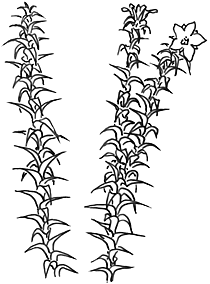| Genus Sprengelia | Family Ericaceae
Subfamily Epacridoideae |

Description: Slender shrubs, glabrous; branches smooth, without leaf scars.
Leaves imbricate, cylindrical and completely sheathing stem at base, narrow-ovate and stem-clasping, then spreading above, acuminate; lamina concolorous, glabrous, finely striate-veined below.
Inflorescence terminal, flowers erect, solitary or sometimes crowded in leafy heads, sessile or shortly pedunculate; bracts numerous, leaf-like, grading to the sepals, persistent. Sepals 5, ovate, acuminate, often white or coloured, glabrous or with ciliate margins. Corolla tube short or with petals free or cohering shortly above the base to form petal claws, glabrous; lobes longer, widely spreading, acute or obtuse, glabrous, imbricate to almost valvate in bud. Stamens free; filaments flat, inserted at base of ovary; anthers partly fused to filament, cohering around the style. Nectary absent. Ovary 5-locular with several ovules per loculus; placentation axile; style inserted in narrow tubular depression in ovary; stigma small, lobed.
Fruit a loculicidal capsule.
Distribution and occurrence: World: 4 species, endemic Australia. Australia: all States except W.A. & N.T.
Text by J. M. Powell, except for groups with contributors listed
Taxon concept:
| | Key to the species | |
| 1 | Diffuse or procumbent shrub; corolla with petals free or cohering for 0.2–0.3 mm at the base | Sprengelia monticola |
| Erect shrubs; corolla with a broad tube, 0.7–6 mm long | 2 |
| 2 | Flowers white, solitary; corolla tube 2–3 mm, rarely to 6 mm long, lobes broad-ovate, more or less obtuse | Sprengelia sprengelioides |
| Flowers pink, often numerous, forming leafy inflorescences 7–20 mm long; corolla tube 0.7–1.3 mm long, lobes narrow-triangular, acute
Back to 1 | Sprengelia incarnata |
|


